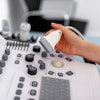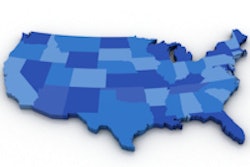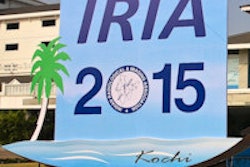
An outstanding musculoskeletal (MSK) fellow with a CV that needs an index emailed yet another academic department. He received no reply. He has a plan B: a second fellowship. He has a plan C: the bridge to nowhere.
I know of three fellows from a respected body imaging program; historically, the graduates of this program were swept up by private practice because of their ability to "destroy lists." These fellows have now undertaken second fellowships.
To clarify, trainees do not generally undertake second fellowships to scale the Tower of Babel. It's an act of last resort.
 Dr. Saurabh Jha.
Dr. Saurabh Jha.
I know of radiologists in a practice who are slowly but surely being asphyxiated by the administration, and who, if not for the oversupply of labor (their replacement would arrive in a nanosecond), would have resigned en masse. The administration knows this. The administration also knows that the radiologists know the administration knows.
Thus the score is administration: 1, radiologists: 0, in case you are wondering.
Let's cut through platitudes and doublespeak and acknowledge that "Houston, we have a problem." The radiology job market is not in crisis, but it needs to be aggressively addressed before it becomes one.
Radiology's labor problem
Radiologists are aware of a problem of value, but do we truly understand the problem?
At the RSNA 2013 show, the echolalia of "value" reached a fever pitch. I could even hear the word from the tarmac of Chicago O'Hare International Airport. One might conclude that if only we read faster, smiled at our referring physicians, asked patients about the well-being of their dog and grandma, volunteered for search and rescue, and spent our vacations performing ultrasounds in Rwanda, all of our fiscal problems would be cured.
Yes, yes, yes, yes, and yes.
This is all just good citizenry and should be encouraged. But who really believes that being Mr. Minnesota Nice will lower the utilization assumption rate from 75% to 50%, or combat the multiple procedure payment reduction (MPPR)?
The U.S. Centers for Medicare and Medicaid Services (CMS) is not cutting rates because radiologists are doing a bad job. CMS is cutting rates because we are doing too much. Allow this point to sink in, because the next point is crucial.
There are too many radiologists.
And many more are arriving on the conveyor belt. We face a problem that falls under Economics 101: abundance.
Abundance devalues, or at least de-prices. If you don't believe me, ask how much you would be willing to pay for a kebab from a vendor in Times Square versus a vendor in Jackson Hole, WY. Kebabs and radiologists are more similar than you might think: Both can be skewered with impunity.
How did we get here?
The easy answer is because residency spots were expanded.
Why? For a rational reason: to deal with a real shortage.
Recall the undersupply of radiologists of the preceding decade. A combination of the contraction of residency positions, unanticipated growth in imaging, and demands for overnight interpretations created an unaccustomed burden on radiologists.
The demand hit academic radiology the hardest. Academic radiologists were fleeing to private practice. Research declined. There was concern that the training of the future workforce would be affected irremediably. Some leaders called upon private practice to help academic departments by paying for fellowship spots for their future hires.
“The radiology job market is not in crisis, but it needs to be aggressively addressed before it becomes one.”
Teleradiology emerged to solve the demand problem -- specifically, the overnight demand. I am sure the irony is not lost. And perhaps we should look in the mirror before labeling teleradiology companies "predatory" for acquiring hospital contracts.
However painful the demand problem, undersupply gave radiologists unprecedented leverage in negotiating contracts, the fruits of which are enjoyed today. Here you have a familiar equation known to fitness enthusiasts: (no) pain, (no) gain.
The expansion of residency spots was partly motivated by the real and palpable pain felt by radiologists who, ironically, were enjoying the gains that undersupply brought. Before anyone points fingers regarding the expansion, one must appreciate that the call for expanding the workforce was loud.
The expansion assumed constancy of reimbursement and continued demand for imaging. We now know that these assumptions were not entirely correct. While there is no shortage of after-the-fact geniuses, nobody -- I mean nobody (I include myself) -- drinking the imaging Kool-Aid asked then what the catch might be. Is the growth real, or will demand regress to the mean? (It has, incidentally.)
Seeing bubbles
Bubbles can be seen with tremendous clarity, in hindsight. But in an industry not governed by price signals, the workforce cannot rapidly adapt to changing demand. Furthermore, the length of training in radiology means the circumstances that motivated the change in labor supply may no longer exist when the finished product emerges.
Precision, so that the supply of trained radiologists fits nicely with the number of jobs on the American College of Radiology (ACR) website, is not possible. Planners must project trends and make assumptions. Historical trends are exactly that. And history may or may not repeat itself exactly. Error is thus unavoidable.
The relevant question when planning the radiology workforce is whether to err on the side of surplus or shortage. This is not a false dichotomy. We will be faced with one or the other.
When tasked with solving a shortage, if one must choose between a projection that potentially oversupplies radiologists and a projection that could still lead to shortage, the latter might not be chosen. Your task, remember, was to solve a shortage.
I would argue, with the benefit of hindsight, of course, that erring towards undersupply is preferable, because it is easier to solve undersupply than oversupply in the short term. Undersupply can be mitigated by opening the gates to non-U.S.-trained radiologists, even if temporarily. Oversupply, as we will find out, is a more vexing problem to solve.
Supply-side economics do not work in radiology
How many unemployed, trained radiologists can the profession abide?
None, or as close to zero as possible.
Aside from the ethical obligation to ensure that an apprentice one has nurtured over four to five years has a job (considerations that do not afflict professors in law or business school to the same extent), unemployment does not bode well for the radiology profession.
The costs of becoming a radiologist are so high that the fear of dismal job prospects reverberates in a nonlinear manner. Simply put, why would anyone go through all the training if the job prospects remain dim?
Because of the relatively fixed pie and high regulatory burden, excess supply cannot create its own demand: It's not easy for a new radiologist to open shop.
Also, radiology wages are sticky: Groups would rather work harder, faster, and with fewer vacation days than hire new personnel and take a wage cut, particularly as no one knows how much the salaries will be hit. No one likes seeing fellows without jobs. But when asked who would be willing to take a salary reduction to open up a job, I do not imagine many hands going up. This is human nature, and the less begrudged the better.
How do we reduce the oversupply?
The simple and simplistic answer is that residency positions need to be reduced, immediately. However, changing residency numbers is an intermediate-term solution, because the effects will be felt five to six years hence. This will not solve the problem in the short term. In the long term, supply and demand will self-correct, but as Keynes famously observed, in the long run we are all dead.
Slashing numbers is not as easy as expanding residencies, however. Who will take the cut: large academic programs or smaller community programs? Who decides? How does one make the process fair?
The resulting internecine conflicts and bickering as each program sends its envoy to make a case for the status quo will further damage the profession.
Whereas the acute pain of shortage was felt by many and produced a motivated lobby, the problems of oversupply are more insidious and disproportionately concentrated on trainees. Needless to say, residents and fellows must stay involved in organized radiology and boldly and repeatedly articulate their concerns and demand solutions.
The market for medical students
In the long run, the supply problem will be corrected by medical students. U.S. medical students are like bond traders. They are savvy about the prospects of the specialties. This is to their credit. They combine a desire of pursuing their intellectual interests with healthy pragmatism.
Historically, radiology has swung from bear to bull market in no time. It was one of the least sought after specialties by medical students during Clintonian healthcare reform, but it rebounded to the top of the charts during the Bush era. The unmatched positions of the past couple of years suggest the bear is back.
Some may celebrate this trend as finally ridding radiology of its Gordon Gekkos -- those who are in it for money -- and enriching it with the spiritual Lamas devoted singularly to pixels. Hallelujah!
Alas, we may be ridding radiology of regular Joes who like imaging but also want to make a living. And we may instead have enriched it with the Gekkos who can't make it in any other discipline.
Assessing the extent of the supply problem
Traditionally, the supply and demand issue has been assessed by surveying groups about their plans to hire new radiologists.
Perhaps a more "in the trenches" method would be to survey fellows and ask how many are doing or have done second fellowships or are planning to work nights (usually not a graduating fellow's first choice). We could also ask about the number of applicants interviewed per position, the delay between interview offered and position offered, the number of positions retracted (i.e., a group says it has an opening for an MSK radiologist and then two weeks later changes its mind), and the length of partnerships.
These surrogates for oversupply should be researched by the Association of Program Directors in Radiology (APDR) and the Resident and Fellow Section (RFS) of the ACR. Trainees, it's your future at stake. Take the lead.
Residency programs should track where their residents end up and how many have completed second fellowships. They should expect to be questioned by medical students on these numbers.
However, fellows must understand that the days of geographical fussiness are well and truly over. Trainees should be prepared to move to the Midwest and northern states, even if raised on the coasts. Little sympathy will be garnered if there is an area of need and jobs but no one available because of a mass desire to be within cycling distance of Manhattan's well-regulated lifestyle.
Short-term solutions
The recent plea in the April 2013 issue of the Journal of the American College of Radiology by Dr. Vijay Rao and Dr. David C. Levin urging practices to hire fellows to prevent further commoditization of the profession nicely highlights the "tragedy of the commons" theory. I wish I could be more optimistic that groups will respond to their plea.
Nonetheless, there is still quite a bit that can be done for fellows.
Reporting of imaging for clinical trials can be handed to graduating fellows. Such reports require detailed and mindless quantification which is not rocket science and does not require 10 years post-American Board of Radiology experience. This will reduce supplemental income for many. But something must give.
Academic departments can keep fellows as adjunct faculty, reducing their fixed costs of setting up shop.
Ultimately, it will be up to the fellows to find creative and disruptive solutions. The rise of "concierge" primary care medicine avails the opportunity for a parallel concierge radiology service. The market always has needs, just not in the conventional manner.
Conclusion
The oversupply of radiologists must instill humility in those who believe in rational planning. The expansion of residency programs was understandable, even in hindsight. But policy is not an exact science. The unavoidable error has consequences. Perhaps more imaginative worst-case scenario forecasting is needed when solutions are proposed.
To be sure, cutting residency spots could lead to a future demand crisis. Our choice is between two unfavorable eventualities: too many or too few radiologists. The forecasting of labor demand is no more reliable than phrenology. Precision is utopian. Imprecision costs.
It is customary to end with optimism. However, the future is truly uncertain for radiologists. The supply problem may be an unseasonal El Niño or the tip of the iceberg; but exist it does.
For fellows, optimism is the only recourse. For planners, it is best to assume that things will only head south. Nobody will blame you if you cried wolf on this issue.
Dr. Saurabh Jha is an assistant professor of radiology at the Hospital of the University of Pennsylvania. He is a superspecialized cardiovascular imager but will grudgingly admit that he is really just a general radiologist who likes the heart more than the posterior fossa.
The comments and observations expressed herein are those of the author and do not necessarily reflect the opinions of AuntMinnie.com.



















